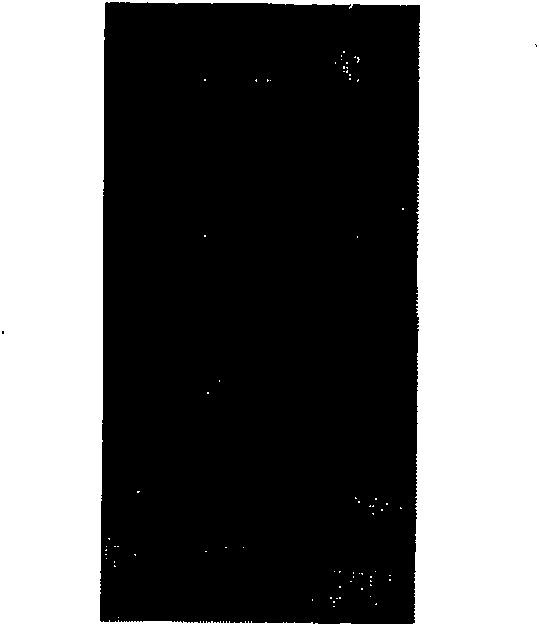CDNA sequence of coding perinereis albuhitensis grube protease and amino acid sequence thereof
A technology of clam worm and protease, which is applied in the field of cDNA sequence and amino acid sequence of clam protease, can solve the problems of no new protease gene sequence of clam worm, low content of protease, development and utilization limitations, etc.
- Summary
- Abstract
- Description
- Claims
- Application Information
AI Technical Summary
Problems solved by technology
Method used
Image
Examples
Embodiment 1
[0032] Example 1: Construction of a cDNA library of C. didentate and the cloning of a cDNA encoding protease:
[0033]1. Using 2 g of Nereis cerevisiae didentate live tissue as material, total RNA was extracted using RNAiso Reagent (TaKaRa Code No. D312).
[0034] 2. Use Oligotex-dT30 mRNA Purification Kit (TaKaRa Code No.9086) to extract mRNA.
[0035] 3. Using 5 μg mRNA as a template, use the TaKaRa cDNA library construction kit to construct a cDNA library, specifically including the following steps:
[0036] (1) Use reverse transcriptase M-MLV and Oligo (dT) anchor primer to synthesize the first strand of cDNA, using 5-methyl dCTP during synthesis;
[0037] (2) Utilize RNaseH, Escherichia coli DNA polymerase and DNA ligase to synthesize the second strand of cDNA;
[0038] (3) using T4 DNA polymerase to smoothen the ends of the double-stranded cDNA;
[0039] (4) Ligate with the linker containing the NotI recognition sequence, and then digest with NotI;
[0040] (5) Use D...
Embodiment 2
[0048] Example 2: Construction of expression vector and expression of cDNA in Escherichia coli:
[0049] 1. According to the obtained cDNA sequence, design a pair of primers
[0050] Primer 1: ACATATGCTGAATGGACCAAG, Primer 2: ACCCTCGAGGAAACCTAAAGTC
[0051] Using the cDNA of C. bidentata protease as a template, Taq DNA polymerase was used to amplify the DNA fragment without the signal peptide coding region. The amplification conditions were: denaturation at 94°C for 45 sec, annealing at 50°C for 45 sec, and extension at 72°C for 1 min. Get 700bp fragment ( figure 1 Middle: 1. PCR product; 2. λDNA / EcoR I+HindIII).
[0052] 2. After cutting with NdeI and XhoI, clone it into the expression vector pET-15b to construct the expression vector pET-15bP, transform the expression vector into E.coliBL21(DE3), and construct the engineering bacteria.
[0053] 3. Pick a single colony of engineering bacteria, inoculate it in 20ml of LB medium containing 100μg / ml ampicillin, culture it wi...
Embodiment 3
[0055] Embodiment 3: Separation and purification of recombinant Bidentate nereis protease
[0056] 1. The lysate of the engineered bacteria induced to express was ultrasonically disrupted, centrifuged at 15,000×g for 30 min at 4°C, and the supernatant was taken.
[0057] 2. The supernatant was passed through a Ni 2+ resin column (2.6×8 cm), and washed with 100 ml of washing solution (20 mM, pH 8.0, 50 mM imidazole, 0.5 M NaCl).
[0058] 3. Elution of binding protein with elution buffer (20mM, pH8.0, 500mM imidazole, 0.5MNaCl) to obtain recombination Bidentate nereis protease, the recombination protein is 28kDa ( image 3 : 1. Medium molecular weight standard protein; 2. Unbound miscellaneous protein; 3. Recombinant Bidentate nereis protease).
PUM
| Property | Measurement | Unit |
|---|---|---|
| molecular weight | aaaaa | aaaaa |
Abstract
Description
Claims
Application Information
 Login to View More
Login to View More - R&D
- Intellectual Property
- Life Sciences
- Materials
- Tech Scout
- Unparalleled Data Quality
- Higher Quality Content
- 60% Fewer Hallucinations
Browse by: Latest US Patents, China's latest patents, Technical Efficacy Thesaurus, Application Domain, Technology Topic, Popular Technical Reports.
© 2025 PatSnap. All rights reserved.Legal|Privacy policy|Modern Slavery Act Transparency Statement|Sitemap|About US| Contact US: help@patsnap.com



